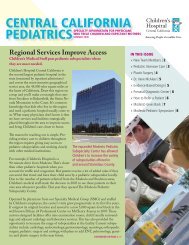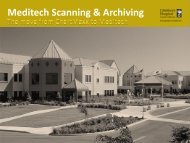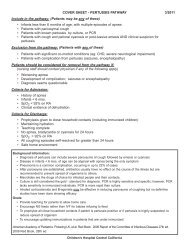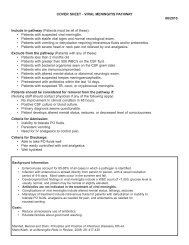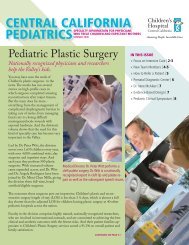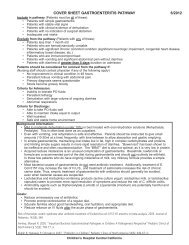Possibilities - Children's Hospital Central California
Possibilities - Children's Hospital Central California
Possibilities - Children's Hospital Central California
You also want an ePaper? Increase the reach of your titles
YUMPU automatically turns print PDFs into web optimized ePapers that Google loves.
Though blessed with the looks of a doll – anangelic face and brown eyes – MichaelaLozano’s world has been far from the perfectimaginary world of Barbie and Ken.Michaela has Intractable Complex Partial Epilepsy,with a Bilateral Foci – a unique neurological disorder,involving recurrent seizures. To make matters worse,she has drug-resistant or “intractable” epilepsy. “We’vetried almost every medication there is,” says her father,Donald Lozano.Normally, one part of the brain misfires, but inMichaela’s condition the temporal lobes – the areaof the brain that controls emotion and memoryfunction – on both sides of her brain misfires.In order to diagnose her condition, Children’sneurology team had to catch a seizure in progress toprove it was epilepsy. The team performed a videoelectroencephalogram (EEG), a lengthy process inwhich Michaela was videotaped while her EEG wasrecorded. An EEG measures the electrical activityin the brain.Only three months old in January 2005, the young girlsuffered her first seizure at her grandparent’s house. Aweek later she had another.TMAKINGMichaela’s been to the <strong>Hospital</strong> numerous times for herseizures. “The first year she had over 20 admissions,”recalls her father. Neurologist Dr. Steven Ehrreich andstaff at Children’s Neurology Practice used medicationREMENDOUS STRIDESDr. Steven Ehrreich and staff at Children’s Neurology Practice, alsoChildren’s Emergency Department and Children’s Outpatient Therapy Services“We had never seen a seizure. We really didn’t know theseriousness of it in the beginning,” says Donald. “Wedidn’t understand the severity of it.”The family chose to take Michaela to Children’s<strong>Hospital</strong> <strong>Central</strong> <strong>California</strong> because of the <strong>Hospital</strong>’sreputation for treating children.“We had no idea of what was going on,” says Michaela’smother, Melissa. “All we knew is that she washaving seizures.”A seizure occurs when the brain receives a burst ofelectrical signals, interrupting normal brain function.Sponsored byKen & SusanBoydto decrease the severity of her condition, but she’s still aregular visitor in the Emergency Department.Today, the adorable 2-year-old receives help atChildren’s Outpatient Therapy Services, where her careincludes occupational, physical and speech therapy fordevelopmental complications.“With all of her therapy, she’s made tremendous strides.Now she’s near age-appropriate on every level,” her momproudly says. “Most children with her condition regress,but Michaela keeps progressing. Each year she getsbetter. The severity of her seizures is decreasing.”Through their experience, Michaela and her familyhave made plenty of friends at Children’s <strong>Hospital</strong>,where Michaela is as popular as Barbie. “We know allthe nurses and they all know Michaela,” says her father.“The <strong>Hospital</strong> is a big part of our support system – thedoctors and physical therapists – along with our familyand friends,” adds Mom.“She still has a chance to grow out of it, there are a lot ofpossibilities,” Mom says, smiling.The staff at Children’s <strong>Hospital</strong> understands possibility.Possibility is what they create every time they help achild like Michaela or any of the other kids you’ve readabout in this book. The future is always waiting to becreated by people with the right type of imagination.Amazing people, who provide incredible care.Photo Sponsor






